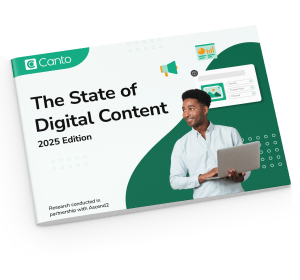How to overcome the most common leadership objections to DAM
| May 22, 2025

You know the content chaos all too well – teams chasing down the latest logo or file version, campaign assets scattered to the wind, last-minute scrambles to meet deadlines. A digital asset management (DAM) platform could solve these problems overnight. But getting leadership buy-in? That’s a different story.
Leadership doesn’t just need to know what DAM is; they need to know why it matters now. That means answering tough questions about cost savings, change management, and how DAM software fits into the bigger picture.
This guide breaks down seven common objections you’ll likely hear from decision makers, along with clear, confident ways to respond to their concerns. As you make the business case for DAM technology, think of this post as your cheat sheet for moving the DAM conversation from hesitance to greenlight.
Objection 1: “It’s too expensive.”
The cost of not having DAM software is even higher.
Leadership wants to protect the bottom line. But the truth is, disorganized content eats away at efficiency and revenue. Teams waste time searching for files, recreating work, and making brand mistakes that cost credibility and, ultimately, money.
DAM software eliminates those inefficiencies. It streamlines workflows, reduces asset duplication, and ensures teams use the right content at the right time, boosting performance and improving return on every marketing investment.
Prove your point: Use Canto’s ROI Calculator to show how DAM software pays for itself.
Objection 2: “We already have tech for this.”
But is the tech you have built for scale or brand control?
If your team toggles between multiple tools to manage assets, you’re missing out on the power of having a single source of truth for your content lifecycle. Without centralized access to pre-approved content, teams waste time searching, duplicating work, or going off brand.
A DAM system brings structure and visibility across departments. It adds automation, AI-powered tools, and intuitive controls that accelerate workflows, enforce brand standards, and give you the scalability your current tech stack can’t. With a DAM platform, your team can work faster, stay consistent, and do more with less.
Prove your point: Audit how many platforms your team uses to manage content. If it’s more than one, a DAM system will save you time and money.

Objection 3: “Adoption will be a challenge.”
Modern DAM platforms are built for easy onboarding.
Ease worries about change management. Today’s DAM systems are user-friendly, even for non-technical teams. Thanks to guided rollouts, role-based access, and hands-on support, it’s easier than ever to successfully adopt a DAM platform.
Prove your point: Share real-world examples, like how Visit Seattle rolled out DAM quickly across teams with great success.
Objection 4: “It won’t integrate with our current tools.”
DAM connects to the tools your teams already use.
A modern DAM platform works with your existing tech stack. From Adobe Creative Cloud to your CMS, project management tools, and even marketing automation tools and social platforms, DAM software keeps every piece of your content lifecycle in sync.
Prove your point: Map our your team’s top tools and confirm integration support with your DAM provider up front.
Objection 5: “We don’t have the bandwidth to implement it.”
Implementation support makes onboarding a DAM platform low lift.
DAM vendors understand that your team is busy. That’s why many platforms offer white-glove onboarding, phased rollout plans, and dedicated customer success managers to get you up and running without overwhelming your team. However, the best DAM platforms provide support beyond the onboarding phase, making sure you can demonstrate DAM ROI to leaders immediately and in the long term.
Prove your point: Highlight how providers like Canto offer implementation packages tailored to your timeline, team size, and long-term goals.
Objection 6: “We’re not sure who would own it.”
DAM ownership can (and should) be shared.
Leadership often hesitates when responsibilities aren’t clear. The good news? DAM software doesn’t require a singular, full-time admin. Successful rollouts typically involve marketing as the driver, IT and creative as implementation partners, and department stakeholders as everyday champions. With flexible permissions and role-based access, everyone can contribute with ease.
Prove your point: Come to the table with a pre-approved project owner and pilot team for your DAM software rollout.
Objection 7: “We don’t create that much content.”
If content is scarce, you still need to maximize its value.
Even small teams with modest content output need a system to protect and amplify their work. DAM software ensures every asset lives longer, performs better, and supports multiple use cases, from sales decks to social campaigns and everything in between.
And once you implement a DAM platform, you’ll be amazed at how much content your teams actually create (and reuse).
Prove your point: Count how many channels your brand shows up on – web, email, events, social, internal comms, etc. Now, bring this number to your DAM pitch and show off DAM’s ability to repurpose content across teams and channels easily.
Ready to make the case for DAM?
Whether you’re facing budget hesitations, tech fatigue, or change resistance, you can make a compelling case for DAM software. Canto is here to help.

